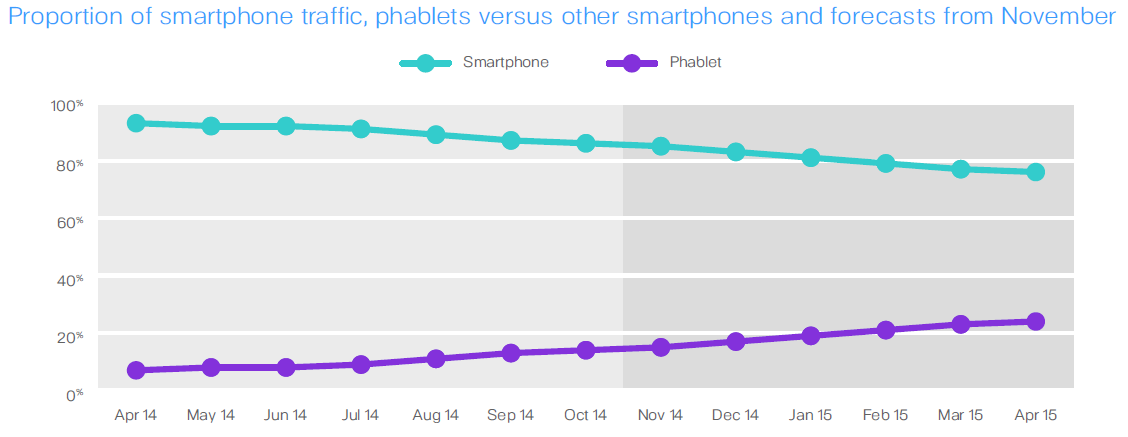Predictions: Top ten mobile trends for 2015

It takes a brave man to make technology predictions in this day and age. Well, never one to shirk a challenge, I’ve been looking into my crystal ball, and with 2015 looming large, I’m putting my head above the parapet to make my top ten mobile predictions for the next 12 months.
Every year, competition in the smartphone space becomes more intense than ever. But we have reached a tipping point. Even the big guns, such as Samsung, are under massive pressure. All vendors will be looking for a killer new differentiator and this means things can (and probably will) get crazy. So, expect to see some wacky concepts making it to the front line of vendor’s product offerings.
1. Origami handsets
Ok, so, not quite, but foldable screens have been on the agenda of many mobile vendors for some time now. The main issue being that to date they have been truly awful in both design and execution. Yet, 2015 may well be the year when vendors (specifically those of the South Korean variety) go hard on foldable screens. Especially as phones are now getting to the size where people are weighing up the hassle of carrying a larger device versus the desire to have a large screen for web browsing. Solving the challenge of viewing experience versus portability could be a huge area of differentiation for many vendors. Could foldable screens be the feature that helps Samsung reverse its recent decline?
2. Bigger screens
The desire for larger screens will grow steadily through 2015. Every study conducted by Netbiscuits in the last 12 months has revealed a consistent conclusion: more people are using their devices primarily as an interface to access the web – and as a "phone" device second. So, the trend towards larger screens will march on throughout 2015.

Source: Netbiscuits Web Trends Report, Q3 2014
Phablets will emerge as the winning market area. This is great news for marketers. Phablets display higher conversion rates, which are much closer to those of tablets. Marketers will need to understand the context in which their users access mobile, not simply just the devices they are using. They will also need to consider what the emergence of this category means for expected bounce and conversion rate targets.
3. "Super" batteries
Batteries will be a huge focus as they become a key consideration for buyers. This will really hit home in the field of wearable tech. Watch out for announcements in 2015 about a "super battery". Google has been snapping up young scientist recruits gearing towards this, and other announcements suggest we are certainly getting closer to a big breakthrough. Nevertheless, it seems that science still has some way to go– and wireless charging is likely to take much longer still. So in the meantime, expect more novel ideas throughout 2015, such as telephone boxes being turned into charging points or smart luggage that powers your phone when you arrive at airports and so on.
All of this is great news for marketers though: customers are desperate to be online and want to be interacting all the time. Mobile traffic will continue its stampede of growth throughout 2015. If you were looking for justification for greater investment in mobile, this is it.
4. Wearables, wearables, wearables
The huge growth of wearable devices will mean an even closer integration of technology into our daily lives. People will become hugely selective about what streams of information they tune in to and out of as these hit their devices. Beyond fitness and health tracking, we will start to see fashion and technology lines begin to blur, as big brands see the importance of making wearable devices more aesthetically pleasing if they are to conquer the mainstream. Expect to see high-end fashion house, such as Gucci break into the wearables revolution.
5. Gestures
Wearables will also prompt growth in the gesture tech. There will be lots of claims throughout the year from companies (such as Aquifi) who will be saying that they want to put gesture tech absolutely everywhere. By the end of the year, we’ll be seeing gesture controlled technology being showcased not only in tablets and mobiles but also in items such as cars, televisions, household appliances and other common user interfaces.
6. Brand loyalty will disappear
People will use websites that work and that deliver content how they want it delivered. There’s huge opportunity here for smaller brands to provide great online, cross-channel, joined-up experiences. Google will help by positively ranking its search results more on user experience across different devices. It will help smaller organizations to differentiate. It will disrupt the old guard of brands that fail to keep up with the pace of change and that are leap-frogged by more agile competitors.
7. Even MORE video
People will consume more video content than ever. Cisco’s Visual Networking Index shows that mobile video traffic already exceeds 50 per cent of mobile data traffic. Marketing will move to visual storytelling. This will be a challenge to get right on mobile, especially given the sheer range of devices and screen sizes that are out there. Animation and video is far trickier to get right than static image and text. As new websites are launched in tune with these shifts in marketing practices, it will be vital for marketers to monitor their impact on site performance and conversion.
8. Privacy will die
People’s expectations of their mobile web experience will be higher than ever. With new technologies, such as contactless payment, becoming more widely accepted, convenience will triumph privacy concerns. More people will share more data than ever before. This will include location and other personal information.
They will share this in return for a great experience. Organizations must be ready to integrate these extra (and quite frankly huge) streams of data into marketing and other business processes.
9. Mobile Big Data needs human intuition as well as hard numbers
More data means increased analytics benchmarking techniques are needed. Data scientists should focus greater effort on testing hypotheses, setting sensible benchmark levels against these and building algorithms to provide automatic feedback alerts, instead of relying only on people to interpret data streams manually. Unlocking the value of data is a huge opportunity for all in 2015. There will be some great success stories to come from organizations that nail this during 2015.
10. Nothing will really change
By the end of 2015, people will still be reading paper books, playing vinyl records, writing in physical notebooks, and paying for things with cash. The digital world exists as an essential overlay to the physical world, but not an outright replacement. Brands that blend experiences across these worlds together (without the user even being consciously aware) will be the brands that win throughout 2015.
Duncan Clark is head of global research at Netbiscuits
Photo credit: Poznyakov/Shutterstock
Published under license from ITProPortal.com, a Net Communities Ltd Publication. All rights reserved.